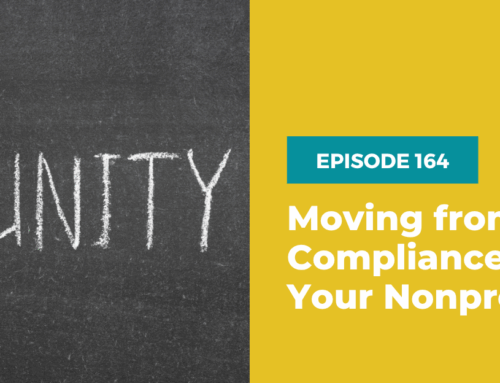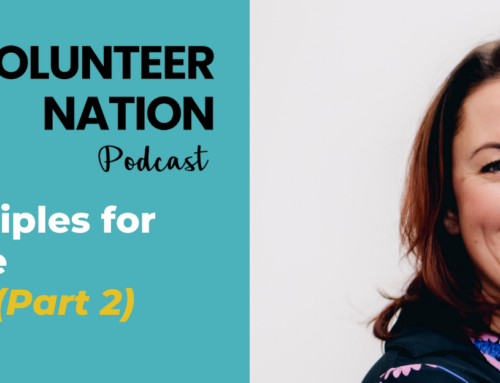
This is How to Create a Successful Volunteer Engagement Strategy
I often get asked what a complete nonprofit volunteer engagement strategy looks like.
What are the pieces? What’s really necessary to get results? How should staffing be structured? How can we pull everything together into a cohesive whole everyone can understand?
So, this week I break it down, soup to nuts.
Taking time to develop a purposeful, ethical, and sustainable model for volunteer involvement can help set the stage for success. Planning for the full volunteer lifecycle can also help you communicate to others the complexity of your work and what kind of support and resources you will need.
Volunteer engagement is both challenging and rewarding. And, in today’s world, it’s getting more and more complex. It takes a real strategy to pull it off successfully.
In this post, I’ll show you how to think through the key elements for your success.
The Volunteer Engagement Cycle
One of the simplest ways to envision what needs to be done is to build a strategy around the volunteer engagement cycle. This approach takes into account each step of the volunteer journey from planning to first touch to onboarding to continuing engagement to departure.
Although nonprofit organizations often focus a tremendous amount of time and energy on recruitment, screening, training and recognition, all steps are important for creating an infrastructure where volunteers can be successful.
In addition, in order to have successful volunteer engagement strategy that gets traction and builds momentum, someone needs to be responsible for each step in the volunteer engagement cycle. These responsibilities may fall on the individual shoulders of the volunteer manager, coordinator, or director.
However, because these tasks are so wide-ranging and time intensive – and they often overlap with other agency functions – it’s often a better option to distribute these throughout departments such as volunteer services, human resources, development, communications, and marketing.
In this way, your volunteer engagement strategy should be integrated throughout the organization. Volunteers, rightly so, become “everyone’s job.” What’s more, staff with expertise and specialization (e.g., communications staff) can focus their talents on optimizing the volunteer journey (e.g., responsible for volunteer recruitment marketing).
When the responsibilities are either too much for one staffer or team, or they are not assigned at all, they won’t likely get done. In the end, your volunteer engagement strategy will suffer.
Key Questions to Fuel Your Volunteer Engagement Strategy
You can start to build your program model by asking some of the key questions I’ve detailed below. They are deceptively simple, but if you answer them thoroughly, and build the programming and support around them, you will have created a foundation for success.
You may want to add questions or tasks to each step that are uniquely important to address in your program or organization.
Also, volunteerism is a two-way street. Volunteers hope to partner with you to bring about change. So, don’t forget to consider volunteer needs at each step, too. In this way, you can proactively promote a positive culture for volunteer involvement that volunteers will love.
Ask yourself these key questions at each step of the volunteer lifecycle…
Needs Analysis
-
- What are your organization’s goals? Where are there gaps?
- What are the risks of volunteer involvement & how will they be mitigated?
- How will volunteers help? In which roles?
- What infrastructure is needed to support & motivate?
Recruitment
-
- Who is your target audience?
- Which messages & messengers will appeal to them?
- Where can you find them?
- What partnerships can help you connect with them?
Screening
-
- What are the minimum requirements for volunteers? What’s nice to have?
- How & when does the volunteer want to offer their support?
- What are the key motivations of the candidate? What are their needs?
- How can you best reward & recognize them in the future?
Placement
-
- What specific role(s) will the volunteers be assigned?
- What is their scheduled length of commitment, minimum & maximum?
- Who will provide them day-to-day support?
- When do they start? What do they need to know beforehand?
Orientation/Training
-
- Who will welcome them to the team?
- What specific technical & interpersonal skills do they need for their role?
- How will orientation to policies & procedures occur?
- How will the training for their role occur, in the classroom & beyond?
Resourcing/Supervision
-
- What tasks will the volunteer do? What is not included in their scope of work?
- How many hours a month is the volunteer expected to commit at a minimum?
- How will work be delegated – by whom to whom?
- Who will directly address problems as they arise? Who is ultimately responsible?
Recognition
-
- How will the team leader or supervisor offer support to volunteers?
- In what ways will individual volunteers & teams be recognized & thanked?
- How will you acknowledge specific achievements, growth & key learning?
- What leadership opportunities will be made available to volunteers?
Retention
-
- How will you report program & policy changes to volunteers?
- How will you gather suggestions & feedback from volunteers?
- How will you address volunteer complaints?
- How will you directly address why volunteers leave?
Evaluation
-
- How will you ensure the ongoing quality of volunteer work?
- How will you track volunteer satisfaction over time?
- How will you assess where program gaps still exist?
- How will you track & report your program goals & achievements?
Culture & Buy-In
-
- How will you promote positive & productive volunteer-staff relations?
- How will you ensure the ongoing quality of volunteer supervision & support?
- How will you ensure that quality program standards & ethical practice are the norm?
- What change management strategies will you use to navigate the inevitable evolutions?
At each step, be sure to consider who will be ultimately responsible for implementing the answers to the questions above.
Also, take into consideration how much time each approach will take, if it will cost money (and how much), and how you will know you have been successful. This will help you assess scope and prioritize, as needed.
You may not be able to tackle every stage all at once. Choose one that has the most promise and start there. Once you realize success, your team will be inspired and your momentum will keep you going.
Operations Planning for Your Volunteer Engagement Strategy

If you don’t know where you’re going, chances are you won’t get there. So, our second key element to successful nonprofit volunteer programs is to develop a volunteer program model.
An operations plan for volunteer services can help organizations think through their entire strategy – soup to nuts – and build a roadmap for success.
As human resources and talent, for the organization, volunteers are a vital fuel to getting things done. So, the plan should relate directly to the agency’s strategic plan and be aligned with the goals and objectives for the coming years
While most nonprofit staff believe they don’t have the time for planning, a well-considered strategy for nonprofit volunteer programs can actually save time in the long-term by pinpointing possible barriers to success so they can be dealt with in a proactive way.
An Operations Plan for volunteer services can also help clearly describe to potential funders how you involve the community directly in your mission, what resources are required for full volunteer engagement, and how you are a responsible steward of funds.
So, set aside dedicated time to develop a complete Operations Plan for Volunteer Involvement that will serve as a blueprint. Like other strategic plans, it should be reviewed and approved by the agency’s governing board before it is implemented.
Once the plan is complete, brief staff on what it contains and what their respective roles are with respect to the plan and volunteers. Supporting volunteers is everyone’s job, and all employees need to understand their roles and responsibilities with respect to their interactions with these supporters.
Nonprofit volunteer programs’ Operations Plans should include the following elements:
- Scope/duration (generally annual)
- Purpose (to improve the impact of volunteer services)
- Lifecycle (to coincide with the agency’s fiscal year)
- Planning Team (volunteer coordinators, executive leadership, key volunteers, consultant, etc.)
- Agency Strategy (how the Operations Plan aligns with the agency’s current Strategic Plan and direction)
- Philosophy of Volunteer Involvement (statement regarding the value of volunteers and why they are considered a strategic asset)
- Core Values (the vision and ethical foundations that drive the plan)
- A Logic Model and Key Performance Indicators (theory of change, expected outcomes, and how its performance will be assessed)
- Environmental Scan (or SWOT Analysis of local context; what will affect volunteering)
- Advertising/Promotions/Marketing (for volunteer program branding and volunteer recruitment, also includes the digital presence)
- Operating Budget for Volunteer Services (cost and funding sources with 10% contingency, can also include planned in-kind resources)
- Service Delivery (volunteer roles in service delivery and customer service standards)
- Staffing and Chart of Accountability (CoA) (human resources that will support the volunteer strategy and who is ultimately responsible for which tasks, including paid staff and key volunteer roles)
- Resources (material sources that will be leveraged or purchased to support volunteer involvement from across the agency)
- Plan Evaluation (methods and planned schedule)
Dedicated Volunteer Services Department or Part of an Existing Team?
When developing a nonprofit Volunteer Program Operations Plan, the question often arises about where the volunteer function should live in the organization. Should it be included as a part of the Development Department, human resources, as separate programs throughout the agency, in its own department? The options are varied.
If volunteers are a fundamental key to your success across your organization, then a dedicated Volunteer Services Department may be a good idea.
A focused team can help sustain, diversify, and grow involvement without distraction and can help standardize volunteer processes and support coach staff as they implement them.
In terms of the number of staff required, it will depend on the strategic goals and activities the department will assume, and the specific tasks required to meet those goals.
At the very least, based on the current scope of volunteer involvement and the goal of diversifying and integrating volunteers across the agency, the department should be led by a Director of Volunteer Services who should have a seat at the management table.
Options for Locating Nonprofit Volunteer Programs: Pros & Cons
The final decision as to where nonprofit volunteer programs should live within an organization’s structure should be made carefully, but decisively. Volunteers are often uncomfortable with changes to staff and management procedures. So, all efforts should be made to implement only one move, if it is deemed necessary.
For a detailed breakdown of the options, check out Where Should the Volunteer Services Department Live on Your Org Chart? HERE >>
The location of choice should be based on the primary goals for volunteer services, where the maximum integration will most likely occur throughout the agency, and where there is departmental capacity, understanding, and enthusiastic support for the volunteer function.
Below are some options:
- OPTION 1: Stand-alone Department Reporting to Executive VP/Human Resources
- OPTION 2: Development Department, Reporting to Director of Development
- OPTION 3: Marketing & Communications Department, Reporting to VP of Marketing & Communications
- OPTION 4: Outreach & Community Partnerships Department, Reporting to VP or Program Director
- OPTION 5: Guest or Client Services Department, Reporting to VP or Program Director
- OPTION 6: Special Events Department, Reporting to VP or Program Director
In the end, there is no “right answer” in terms of where nonprofit volunteer programs should be placed within the organization’s structure.
However, volunteer coordination and program administration are best consolidated into one department to reduce duplication of effort, to better coordinate volunteer communications and training, and to centralize data collection and reporting.
In addition, the volunteer function should be memorialized in an Operations Plan that is known not only within the department primarily responsible for volunteers, but throughout the organization as a whole.
Finally, while a single department may be accountable for the majority of operations, it should be made clear to all teams and staff how each is expected to support and champion nonprofit volunteer programs and efforts.







Leave A Comment